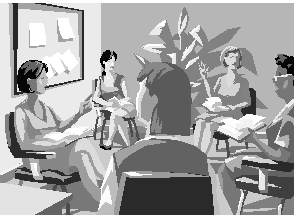Tools for Teaching Navigation
Tools for Teaching: Introduction
Facilitation Skills: The Art of Group Facilitation
- Self-Mastery Skills: What Does It Mean to Be a Facilitator?
- Presence and Presentation Skills
- Relating Skills: Communication, Listening, Questioning
- Group Awareness and Management Skills
- Logistic Skills
- References
Teaching and Presentation Skills: Keep these techniques in mind
What is a facilitator?
There are two broad types of facilitators (Schwarz, 2002).
A facilitator is often viewed as a neutral third party, content neutral individual who helps to increase the effectiveness of a group or organization by helping with group process. This person advocates for fair, open and inclusive procedures and does not advocate a particular point of view. The key is that the facilitator is acceptable to all members of the group and has no decision-making authority. Remember: the facilitator is the process expert and can help improve the way the group identifies problems, solves problems, and makes decisions. Typically this type of facilitator works with a group on a short-term basis to solve a problem or help develop long-range or strategic plans.
 The second type of facilitator is the facilitative leader. This person is a member of the group or organization and is vested in the group and its mission. He or she is a process and content expert. This person has many of the same skills as the outside facilitator, but uses them on a routine basis to help the group move forward. The facilitative leader, like the outside facilitator, uses fair, open and inclusive procedures to enable all members to participate but can also voice his or her own views.
The second type of facilitator is the facilitative leader. This person is a member of the group or organization and is vested in the group and its mission. He or she is a process and content expert. This person has many of the same skills as the outside facilitator, but uses them on a routine basis to help the group move forward. The facilitative leader, like the outside facilitator, uses fair, open and inclusive procedures to enable all members to participate but can also voice his or her own views.
Reference
Schwarz, R. 2002. The Skilled Facilitator. A Comprehensive Resource for Consultants, Facilitators, Managers, Trainers, and Coaches, revised version. Jossey-Bass: San Francisco, CA.
Adapted with permission from Soil and Water Conservation District Outreach: A Handbook for Program Development, Implementation and Evaluation. Ohio Department of Natural Resources, Division of Soil and Water Conservation, 2003.



